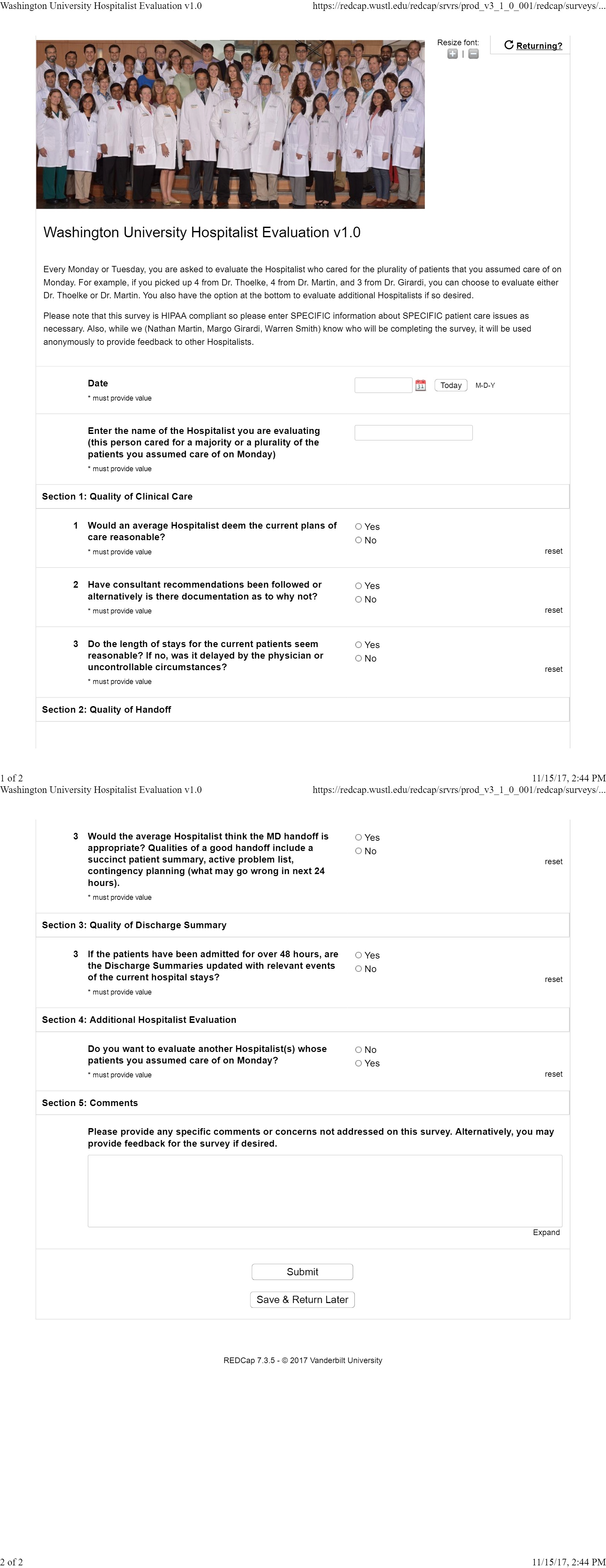Background: The Hospitalist Division at Washington University in St. Louis provides coverage for multiple different services at Barnes-Jewish Hospital. At the present time, there are a total of 68 MDs and 6 NPs caring for greater than 100 patients on a daily basis. Our main Hospital Medicine service is comprised of 11 different Hospitalist attending each caring for 8 to 15 patients per day. These teams work each Monday through Sunday from 7 AM to 7 PM. It is an expectation that each patient will have a reasonable plan of care, a completed cogent handoff, and a thorough updated discharge summary at the end of each week. Over the years, it has become obvious that there are many different practice patterns as well as methods to communicate plans for the next Hospitalist assuming care of the patient the following Monday prompting a standardized tool to evaluate this process.
Purpose: We formulated a survey using the REDCap software to assess the quality of care within our division. Areas that we felt needed primary focus included the “Quality of Clinical Care,” the “Quality of Handoff,” and the “Quality of Discharge Summary.” These were 3 areas of care that have led to frustrations over the years given the variable degree of quality. We felt that a weekly survey evaluating the prior Hospitalist would help improve the quality of care for our patients by improving communication and handoffs. We also felt this survey would improve job satisfaction by making an often challenging Monday a smoother transition with the knowledge that the previous Hospitalist had provided the best possible care.
Description: : Every Monday at 7 AM an email goes out via the REDCap interface to each Hospitalist starting service that day and links them to a website to a complete the survey. See attached graphic labelled Hospitalist Evaluation that shows the web interface each person encounters. Once an option is selected on each question, a comment box opens up allowing more detailed information. We have encouraged everyone to provide very specific details regarding patient care and handoff details to aid in overall improvement of our group. As the REDCap software is HIPAA compliant at our institution, we are able to obtain detailed patient care issues in the survey to reference at a later date if needed. Once the Hospitalist completes the survey, the data is stored and can only be accessed by one of the investigators on the project.To date, we have collected three months of weekly evaluations and recently provided the feedback back to the evaluated Hospitalists via a PDF packet of the collected data. Going forward, we hope to have a more regular feedback mechanism and plan to add another question to aid in the quality of the admitting process by our Nocturnists.
Conclusions: In conclusion, we feel that a robust evaluation system will aid in the quality of care that we deliver to our patients at Barnes-Jewish Hospital and improve our handoff communication of complex medical cases. One challenge has been completion of this survey in a timely manner due to a busy patient schedule and we are continuing to work on ways to improve our weekly compliance. We plan on providing quarterly feedback and believe this survey will help provide meaningful feedback to not only our young hospitalists just starting their careers, but help fine tune our senior hospitalist as to what they can expand on in the future. In conclusion we hope that this evaluation model can become a standard throughout hospitalist groups nationwide.

